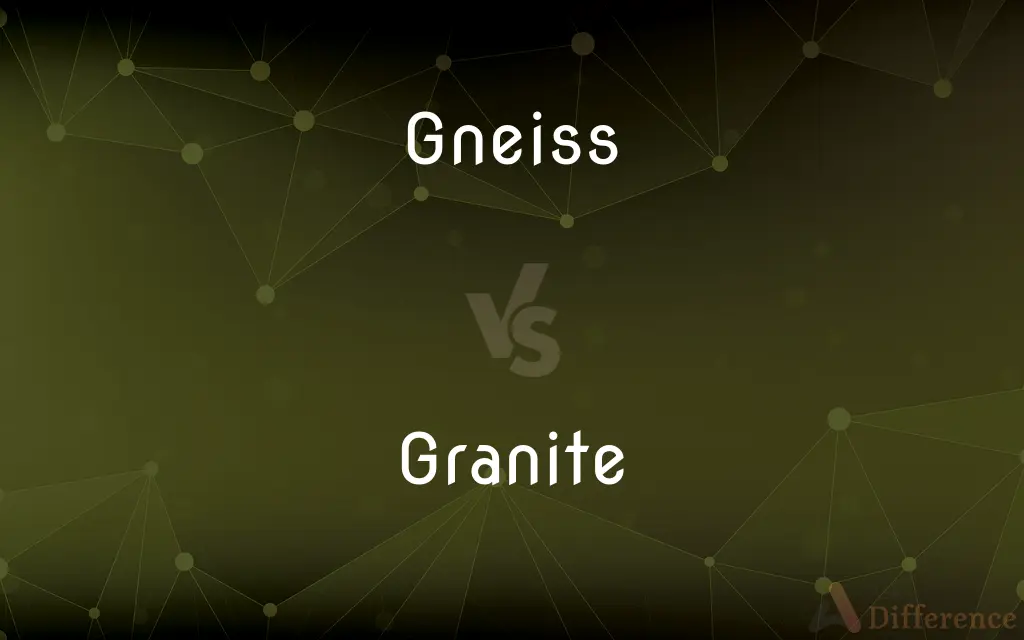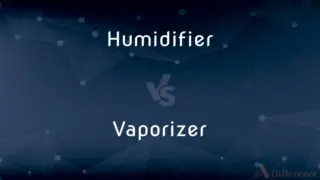Gneiss vs. Granite — What's the Difference?
By Tayyaba Rehman — Updated on November 1, 2023
Gneiss is a high-grade metamorphic rock with banded patterns formed from pre-existing rocks under extreme pressure and temperature. Granite is a coarse-grained igneous rock formed from cooled magma, abundant in quartz and feldspar.

Difference Between Gneiss and Granite
Table of Contents
ADVERTISEMENT
Key Differences
Gneiss is a metamorphic rock characterized by its foliated texture, meaning it has a layered or banded appearance. Granite is an igneous rock, which means it crystallized from molten material, with a granular and phaneritic texture. The banding in gneiss is due to the high-pressure and temperature conditions it was subjected to, which realign the minerals into layers.
Granite forms as magma cools slowly underground, creating large, visible crystals of quartz, feldspar, and mica. In contrast, gneiss has been further transformed by heat and pressure, resulting in a distorted structure where bands of light and dark minerals are visible. Granite's crystals interlock like a jigsaw puzzle, giving it strength and a grainy texture.
Gneiss usually forms from the metamorphism of granite or sedimentary rock, meaning it's essentially granite or a similar rock that has been deeply buried and heated. Granite, however, comes from a completely liquid state and is a primary rock, not derived from any previous rock forms. Gneiss's composition can vary greatly, depending on the composition of the original rock and the conditions of metamorphism.
The foliation in gneiss makes it a preferred material for certain architectural and artistic applications, adding a decorative element due to its unique banding. Granite, with its durability and aesthetic appeal due to its varied minerals and color, is widely used for countertops, monuments, and building facades. While gneiss can also be durable, it's often used in areas where its distinctive patterns will be visible.
Although both gneiss and granite are used in construction, they each have different applications based on their physical properties. Gneiss's banded appearance gives it a more varied look, while granite's uniformity is often preferred for interior design. The structural integrity of gneiss can sometimes be less predictable due to its foliation, whereas granite is renowned for its strength and resistance to weathering.
ADVERTISEMENT
Comparison Chart
Type of Rock
Metamorphic
Igneous
Formation Process
From pre-existing rocks under pressure and temperature
From cooling magma
Texture
Foliated, banded
Granular, phaneritic
Composition Variability
Variable, depending on parent rock
Relatively consistent (quartz, feldspar, mica)
Usage
Ornamental, architectural with visible banding
Widely used in construction and monuments
Compare with Definitions
Gneiss
Characterized by alternating light and dark mineral bands
The gneiss showed distinct banding.
Granite
Used commonly for countertops due to its durability
Granite countertops are easy to clean.
Gneiss
Formed by high-grade metamorphism
This gneiss formed from ancient volcanic rocks.
Granite
A coarse-grained igneous rock
The granite cliffs towered above the valley.
Gneiss
Often used in construction for its decorative patterns
Gneiss tiles are popular for floors.
Granite
Composed mainly of quartz and feldspar
This granite is prized for its pink feldspar.
Gneiss
A metamorphic rock with a banded texture
The building was faced with polished gneiss.
Granite
Formed from slowly cooled magma
This granite cooled deep beneath the Earth's surface.
Gneiss
Potentially derived from granite or sedimentary rocks
The gneiss here once was granite.
Granite
Popular for monuments and buildings
The courthouse was built with gray granite.
Gneiss
Gneiss ( nyse) is a common and widely distributed type of metamorphic rock. Gneiss is formed by high-temperature and high-pressure metamorphic processes acting on formations composed of igneous or sedimentary rocks.
Granite
Granite () is a coarse-grained igneous rock composed mostly of quartz, alkali feldspar, and plagioclase. It forms from magma with a high content of silica and alkali metal oxides that slowly cools and solidifies underground.
Gneiss
A banded or foliated metamorphic rock, usually of the same composition as granite.
Granite
A common, coarse-grained, light-colored, hard igneous rock consisting chiefly of quartz, orthoclase or microcline, and mica, used in monuments and for building.
Gneiss
(geology) A common and widely-distributed metamorphic rock having bands or veins, but not schistose.
Granite
Unyielding endurance; steadfastness
A will of granite.
Gneiss
A crystalline rock, consisting, like granite, of quartz, feldspar, and mica, but having these materials, especially the mica, arranged in planes, so that it breaks rather easily into coarse slabs or flags. Hornblende sometimes takes the place of the mica, and it is then called hornblendic gneiss or syenitic gneiss. Similar varieties of related rocks are also called gneiss.
Granite
(rock) A group of igneous and plutonic rocks composed primarily of feldspar and quartz. Usually contains one or more dark minerals, which may be mica, pyroxene, or amphibole. Granite is quarried for building stone, road gravel, decorative stone, and tombstones. Common colors are gray, white, pink, and yellow-brown.
Gneiss
A laminated metamorphic rock similar to granite
Granite
Toughness; the quality of having a thick skin or being rough.
Granite
A crystalline, granular rock, consisting of quartz, feldspar, and mica, and usually of a whitish, grayish, or flesh-red color. It differs from gneiss in not having the mica in planes, and therefore in being destitute of a schistose structure.
Granite
Plutonic igneous rock having visibly crystalline texture; generally composed of feldspar and mica and quartz
Granite
Something having the quality of granite (unyielding firmness);
A man of granite
Common Curiosities
What makes the banding in gneiss?
The banding is due to the reorientation of minerals under extreme pressure and temperature.
What is gneiss used for?
Gneiss is used in construction, decoration, and for artistic purposes due to its banded appearance.
Can granite become gneiss?
Yes, through high-grade metamorphism, granite can transform into gneiss.
Can gneiss contain granite components?
Yes, gneiss can form from the metamorphism of granite.
Is granite stronger than gneiss?
Granite is generally more uniformly strong, but gneiss can be just as strong depending on its formation.
Is gneiss suitable for kitchen countertops?
It's not as common as granite, which is preferred for its uniformity and durability.
Can you find fossils in gneiss?
It's unlikely, as the metamorphic process would destroy any fossils.
Are there different types of gneiss?
Yes, depending on the composition of the original rock and metamorphic conditions.
Does the color of granite vary?
Yes, it can vary widely depending on its mineral composition.
What's the main visual difference between gneiss and granite?
Gneiss has a banded appearance, while granite has a more uniform, speckled look.
Is gneiss more expensive than granite?
It can be, depending on availability and the uniqueness of the bands.
How is granite formed?
Granite forms when magma cools slowly beneath the Earth's surface.
Are gneiss and granite used interchangeably in construction?
Not usually, as their different appearances and properties suit different applications.
Do gneiss and granite have the same minerals?
They can share similar minerals, but their compositions may differ.
Why is granite more popular for interior design?
Its durability, consistent pattern, and wide variety of colors make it versatile for design.
Share Your Discovery

Previous Comparison
Swim vs. Swimming
Next Comparison
Humidifier vs. VaporizerAuthor Spotlight
Written by
Tayyaba RehmanTayyaba Rehman is a distinguished writer, currently serving as a primary contributor to askdifference.com. As a researcher in semantics and etymology, Tayyaba's passion for the complexity of languages and their distinctions has found a perfect home on the platform. Tayyaba delves into the intricacies of language, distinguishing between commonly confused words and phrases, thereby providing clarity for readers worldwide.
















































